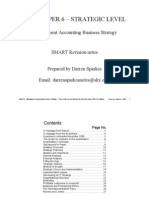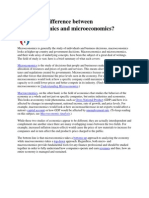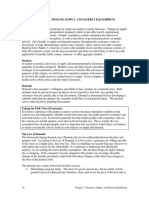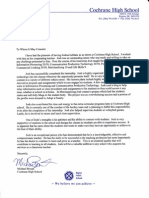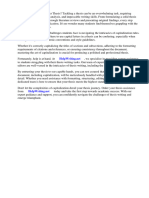Lesson 7 Elasticity
Uploaded by
leblanjoLesson 7 Elasticity
Uploaded by
leblanjoIn economics, its generally helpful to have some measure of how responsive consumers and producers are to changes in price.
In some cases, consumers will just grin and bear a price increase, while in other situations they will avoid the more expensive product like the plague. Similarly, sometimes suppliers will greatly increase production when they see higher prices to be had, and sometimes they are stuck with a certain level of capacity and thus an upper limit on output (at least in the short term). Also, economists find that people often think about these decisions in terms of relative price changes rather than absolute ones. For example, people report that they are much more willing to drive out of their way to save $10 on a $30 calculator than to save $10 on a $2000 computer, even though they are saving the same $10 in either case. (Yes, this is an actual study. The numbers may not be exactly accurate, since I couldnt find a good reference online, but the right idea is there.) As such, economists use the concept of elasticity, which is defined as a ratio of relative changes. We will look at two types of price elasticity; demand and supply. Price Elasticity of Demand measures the extent to which the quantity of a product demanded responds to a change in price, while Price Elasticity of Supply measures change in the amount supplied by companies in response to a change in price. Calculating and Determining Elasticity Economists have special formulas that they use to determine the elasticity of both demand and supply. In each calculation you are trying to determine a number or coefficient that will help us in classifying the type of Elasticity. Calculating Elasticity of Demand To calculate the elasticity for demand the following formula is used. When we calculate a coefficient we are only concerned with absolute value. Therefore if the final coefficient is negative, we ignore that sign and look at it as positive.
But before you can use this formula you have to be able to determine the percent change in both the quantity demanded and the change in price. You will be given information every time that you calculate elasticity. Using the
information in the chart you will determine the numbers that you will use to find your coefficient. To do this we use the following formulas:
Once you have these two numbers you can complete CED equation and determine the type of elasticity. Lets look at an example: You are a manufacturer for a CD Company. It has been determined that you are going to change the price for your CD`s along with you packaging options. The following table was presented to you. Find the Demand Coefficient. Old 9 150 New 10 110
Price Demand
Step 1: Determine the Change in Quantity Demanded
Step 2: Determine the Change in Price
Step 3: Determine the CED
Once you have found the coefficient, you can than classify the elasticity. The higher the price elasticity, the more sensitive consumers are to price changes. Very high price elasticity suggests that when the price of a good goes up, consumers will buy a great deal less of it and when the price of that good goes down, consumers will buy a great deal more. Very low price elasticity implies just the opposite, that changes in price have little influence on demand.
If Elasticity of Demand is > 1 then Demand is Price Elastic (Demand is sensitive to price changes) If Elasticity of Demand is = 1 then Demand is Unit Elastic If Elasticity of Demand is < 1 then Demand is Price Inelastic (Demand is not sensitive to price changes)
Recall that we always ignore the negative sign when analyzing price elasticity, so Elasticity of Demand is always positive. In the case of our good, we calculated the price elasticity of demand to be 2.4005, so our good is price elastic and thus demand is very sensitive to price changes.
Factors Affecting Demand Elasticity There are three main factors that influence a demand's price elasticity: 1. The availability of substitutes - This is probably the most important factor influencing the elasticity of a good or service. In general, the more substitutes, the more elastic the demand will be. For example, if the price of a cup of coffee went up by $0.25, consumers could replace their morning caffeine with a cup of tea. This means that coffee is an elastic good because a raise in price will cause a large decrease in demand as consumers start buying more tea instead of coffee. However, if the price of caffeine were to go up as a whole, we would probably see little change in the consumption of coffee or tea because there are few substitutes for caffeine. Most people are not willing to give up their morning cup of caffeine no matter what the price. We would say, therefore, that caffeine is an inelastic product because of its lack of substitutes. Thus, while a product within an industry is elastic due to the availability of substitutes, the industry itself tends to be inelastic. Usually, unique goods such as diamonds are inelastic because they have few if any substitutes.
2. Amount of income available to spend on the good - This factor affecting demand elasticity refers to the total a person can spend on a particular good or service. Thus, if the price of a can of Coke goes up from $0.50 to $1 and income stays the same, the income that is available to spend on coke, which is $2, is now enough for only two rather than four cans of Coke. In other words, the consumer is forced to reduce his or her demand of Coke. Thus if there is an increase in price and no change in the amount of income available to spend on the good, there will be an elastic reaction in demand; demand will be sensitive to a change in price if there is no change in income. 3. Time - The third influential factor is time. If the price of cigarettes goes up $2 per pack, a smoker with very few available substitutes will most likely continue buying his or her daily cigarettes. This means that tobacco is inelastic because the change in price will not have a significant influence on the quantity demanded. However, if that smoker finds that he or she cannot afford to spend the extra $2 per day and begins to kick the habit over a period of time, the price elasticity of cigarettes for that consumer becomes elastic in the long run. Examples of Goods that Have Inelastic Demands Petrol petrol has few alternatives because people with a car, need to buy petrol. For many driving is a necessity. There are weak substitutes, such as train, walking and the bus. But, generally, if the price of petrol goes up, demand proves very inelastic. Salt. If the price of salt increased, demand would largely be unchanged. It is only a small % of income and people tend to buy infrequently. It is a good with no real substitutes at all. Good produced by a monopoly. Any good produced by a monopoly is likely to be inelastic demand. For example, if Sky increase the cost of premiership pay per view, many football fans will pay the extra price. Though because it isnt a necessity, demand may be less inelastic than say petrol. Tap water. For householders, tap water is a necessity, with no alternatives. If the water companies increase the cost of water bills, people would keep buying the service. It would have to rise to a very high price before people disconnected their water supply. This is why tap water is regulated. Diamonds. Bought very infrequently, diamonds are the ultimate luxury with few exact alternatives. You could buy other precious gems, but others may not have the same allure as diamonds. A cut in price wouldnt increase demand very much. Cigarettes. If cigarette tax increases and the price of all tobacco increases, demand will be inelastic because many smokers are addicted and dont have any alternatives to keep buying. Apple iPhones, iPads. The Apple brand is so strong that many consumers will pay a premium for apple products. If the price rises for apple iPhone, many will
continue to buy. If it was a less well known brand like Dell computers, you would expect demand to be price elastic. Examples of Goods that Have Elastic Demands Heinz soup. These days there are many alternatives to Heinz soup. If price rises, people will switch to less expensive varieties. Shell petrol. We say that petrol is overall inelastic. But, if an individual petrol station increases price, people will buy from other petrol stations. The only exception is if a petrol station has a local monopoly e.g. at service station on the motorway there is a captive audience. But, in a city centre with many alternatives, people will have an elastic demand. Tesco bread. Tesco bread will be highly price elastic because there are many better alternatives. If the price of Tesco bread rises, consumers will switch to alternatives. Daily Express. If the Daily express increases in price, there are similar newspapers people will switch to. For example, the Daily Mail or Daily Mirror. If it was a newspaper like the Financial Times of the Economist, demand would be more inelastic, as there is no close substitute to the Financial Times. Aero chocolate bar. If Aeros increase, people will switch to alternative types of chocolate bar. Porsche sports car. If a Porsche increases, demand will probably be elastic because it is a high % of income, and so the higher price will put people off. Also, there are other alternatives, such as Jaguar or Aston Martin. However, this is a little less clear cut. Some car enthusiasts may want to buy a Porsche whatever the price.
Calculating Elasticity of Supply To calculate the elasticity for supply the following formula is used. When we calculate a coefficient we are only concerned with absolute value. Therefore if the final coefficient is negative, we ignore that sign and look at it as positive.
But before you can use this formula you have to be able to determine the percent change in both the quantity supplied and the change in price. You will be given information every time that you calculate elasticity. Using the information in the chart you will determine the numbers that you will use to find your coefficient. To do this we use the following formulas:
Once you have these two numbers you can complete CES equation and determine the type of elasticity. Lets look at an example: You are a manufacturer for a CD Company. It has been determined that you are going to change the price for your CD`s along with you packaging options. The following table was presented to you. Find the Supply Coefficient. Old 9 150 New 10 110
Price Supplied
Step 1: Determine the Change in Quantity Supplied
Step 2: Determine the Change in Price
Step 3: Determine the CES
Once you have found the coefficient, you can than classify the elasticity. The price elasticity of supply is used to see how sensitive the supply of a good is to a price change. The higher the price elasticity, the more sensitive producers and sellers are to price changes. A very high price elasticity suggests that when the price of a good goes up, sellers will supply a great deal less of the good and when the price of that good goes down, sellers will supply a great deal more. A very low price elasticity implies just the opposite, that changes in price have little influence on supply.
If Elasticity of Supply is > 1 then Supply is Price Elastic (Supply is sensitive to price changes) If Elasticity of Supply is = 1 then Supply is Unit Elastic If Elasticity of Supply is < 1 then Supply is Price Inelastic (Supply is not sensitive to price changes)
Recall that we always ignore the negative sign when analyzing price elasticity, so Elasticity of Supply is always positive. In our case, we calculated the price elasticity of supply to be 2.4005, so our good is price elastic and thus supply is very sensitive to price changes. Factors Affecting Supply Elasticity There are a few factors that determine how elastic supply (i.e. how responsive quantity supply is to changes in prices) for a particular good is: 1. Time: Supply will be different in the short and long run with time. In the short run, firms will only be able to increase input of labour to increase supply of commodities. Supply change will be little because other factors of production may not be increased in the same proportion as the change in price and may limit the supply. However, in the long run a firm will increase the input of all factors of production and thus the supply becomes more price elastic.
2. Availability of resources: If the economy is already using most of its scarce resources, then firms will find it difficult to employ more (i.e. workers) and so output will not be able to rise. The supply of most goods and services will therefore be price inelastic, and vice versa. 3. Number of producers: If there are more producers, this means that the output can be increased more easily. Thus supply is more elastic as a result.
4. Ease of storing stocks: The type of good that a producer supplies will affect elasticity. If goods can be stocked with ease and have a long shelf life, then supply will be elastic. Otherwise the goods will be inelastic. For example, perishable goods such as fresh flowers, vegetables have comparatively inelastic supply because it is difficult to store them for longer periods. 5. Increase in cost of production as compared to output: In cases where there is a significant increase in cost of production when output is increased, supply is inelastic. This is because suppliers would have to make a significant investment in order to increase the output. This would take time and some suppliers may be hesitant in doing so. 6. Improvements in Technology: Some industries will have improvements in technology that affects the price elasticity of supply. Improvements lead to goods being more elastic (i.e. firms are more efficient in production- better machinery so output is increased greater with increase in price) as compared to industries where there are less improvements. 7. Stock availability of finished goods: In some industries where there are higher inventories or stock of finished goods, the supplier can supply more as the price rises. Thus, the price elasticity of supply for these goods will be elastic.
You might also like
- Economics for CFA 2024: level 1 in just one week: CFA level 1, #4From EverandEconomics for CFA 2024: level 1 in just one week: CFA level 1, #44.5/5 (2)
- Chapter 15: Capital Structure Decisions: Page 1100% (1)Chapter 15: Capital Structure Decisions: Page 164 pages
- The Effect of Inflation To The Economic Growth of The Philippines64% (14)The Effect of Inflation To The Economic Growth of The Philippines27 pages
- Objectives For Chapter 4: Elasticity and Its ApplicationNo ratings yetObjectives For Chapter 4: Elasticity and Its Application19 pages
- Economics Basics: Elasticity: Sponsor: Cook Up A Market-Stomping Stock Portfolio With Our FREE ReportNo ratings yetEconomics Basics: Elasticity: Sponsor: Cook Up A Market-Stomping Stock Portfolio With Our FREE Report4 pages
- The Relationship Between The Price of A Good and How Much of It SB Wants To BuyNo ratings yetThe Relationship Between The Price of A Good and How Much of It SB Wants To Buy6 pages
- Factors That Determines The Elasticity of Demand100% (1)Factors That Determines The Elasticity of Demand4 pages
- Examples of elasticity - Economics HelpNo ratings yetExamples of elasticity - Economics Help12 pages
- downloadEconomicsA LevelNotesEdexcel ATheme 1Summary1.2.20How20Markets20Work PDFNo ratings yetdownloadEconomicsA LevelNotesEdexcel ATheme 1Summary1.2.20How20Markets20Work PDF37 pages
- Chapter 3: Demand, Supply, and Market Equilibrium 16No ratings yetChapter 3: Demand, Supply, and Market Equilibrium 1615 pages
- P in Brief, Are As Under:: 0 in Developing Countries of The World, TheNo ratings yetP in Brief, Are As Under:: 0 in Developing Countries of The World, The4 pages
- Price Elasticity of Demand: Price Elasticity % Change in Quantity / % Change in PriceNo ratings yetPrice Elasticity of Demand: Price Elasticity % Change in Quantity / % Change in Price13 pages
- Elasticity Continued : Determinants of Price Elasticity of DemandNo ratings yetElasticity Continued : Determinants of Price Elasticity of Demand24 pages
- Theory of Production: Short-Run Analysis: Average Product (AP)No ratings yetTheory of Production: Short-Run Analysis: Average Product (AP)15 pages
- Week 4 - Chapter 4 - Elasticity of Supply and DemandNo ratings yetWeek 4 - Chapter 4 - Elasticity of Supply and Demand2 pages
- Karan Desai - GB540M2 - Examine Microeconomic Tools - Competency AssessmentNo ratings yetKaran Desai - GB540M2 - Examine Microeconomic Tools - Competency Assessment7 pages
- Script for market, law of supply and demantNo ratings yetScript for market, law of supply and demant6 pages
- The Own-Price Elasticity of Demand For Food Is NegativeNo ratings yetThe Own-Price Elasticity of Demand For Food Is Negative3 pages
- IB Economics SL (Chapter 1.1 Competitive Markets)No ratings yetIB Economics SL (Chapter 1.1 Competitive Markets)13 pages
- Marginal Utility and The Law of Diminishing Marginal UtilityNo ratings yetMarginal Utility and The Law of Diminishing Marginal Utility5 pages
- Josh.R.Leblanc@Gmail: Joshua Leblanc Permanent Address Current AddressNo ratings yetJosh.R.Leblanc@Gmail: Joshua Leblanc Permanent Address Current Address3 pages
- Lape - ACP312 - ULOa - Let's Analyze Week6No ratings yetLape - ACP312 - ULOa - Let's Analyze Week63 pages
- Strategic Management Presentation - Coca ColaNo ratings yetStrategic Management Presentation - Coca Cola66 pages
- Introduction To Haulage Business in Nigerian PortsNo ratings yetIntroduction To Haulage Business in Nigerian Ports2 pages
- SEC Complaint Against Michael W. Perry and A. Scott KeysNo ratings yetSEC Complaint Against Michael W. Perry and A. Scott Keys26 pages
- Real Estate Cycle Methodology: SpecialreportNo ratings yetReal Estate Cycle Methodology: Specialreport5 pages
- Kogta Financial India Limited - Bali 01 2024No ratings yetKogta Financial India Limited - Bali 01 20247 pages
- Market Segments of National Stock ExchangeNo ratings yetMarket Segments of National Stock Exchange9 pages
- Satya M Sca M Was Caught Way Back in October 2008No ratings yetSatya M Sca M Was Caught Way Back in October 200815 pages
- Negotiable Instruments Law: CASES: Phil. Educ. Co., Inc. vs. Soriano, 39 SCRA 587 TibajiaNo ratings yetNegotiable Instruments Law: CASES: Phil. Educ. Co., Inc. vs. Soriano, 39 SCRA 587 Tibajia8 pages
- MBA Thesis Determinants of Banking Sector Development in Ethiopia-95 PgeNo ratings yetMBA Thesis Determinants of Banking Sector Development in Ethiopia-95 Pge95 pages
- Economics for CFA 2024: level 1 in just one week: CFA level 1, #4From EverandEconomics for CFA 2024: level 1 in just one week: CFA level 1, #4
- The Effect of Inflation To The Economic Growth of The PhilippinesThe Effect of Inflation To The Economic Growth of The Philippines
- Objectives For Chapter 4: Elasticity and Its ApplicationObjectives For Chapter 4: Elasticity and Its Application
- Economics Basics: Elasticity: Sponsor: Cook Up A Market-Stomping Stock Portfolio With Our FREE ReportEconomics Basics: Elasticity: Sponsor: Cook Up A Market-Stomping Stock Portfolio With Our FREE Report
- The Relationship Between The Price of A Good and How Much of It SB Wants To BuyThe Relationship Between The Price of A Good and How Much of It SB Wants To Buy
- downloadEconomicsA LevelNotesEdexcel ATheme 1Summary1.2.20How20Markets20Work PDFdownloadEconomicsA LevelNotesEdexcel ATheme 1Summary1.2.20How20Markets20Work PDF
- Chapter 3: Demand, Supply, and Market Equilibrium 16Chapter 3: Demand, Supply, and Market Equilibrium 16
- P in Brief, Are As Under:: 0 in Developing Countries of The World, TheP in Brief, Are As Under:: 0 in Developing Countries of The World, The
- Price Elasticity of Demand: Price Elasticity % Change in Quantity / % Change in PricePrice Elasticity of Demand: Price Elasticity % Change in Quantity / % Change in Price
- Elasticity Continued : Determinants of Price Elasticity of DemandElasticity Continued : Determinants of Price Elasticity of Demand
- Theory of Production: Short-Run Analysis: Average Product (AP)Theory of Production: Short-Run Analysis: Average Product (AP)
- Week 4 - Chapter 4 - Elasticity of Supply and DemandWeek 4 - Chapter 4 - Elasticity of Supply and Demand
- Karan Desai - GB540M2 - Examine Microeconomic Tools - Competency AssessmentKaran Desai - GB540M2 - Examine Microeconomic Tools - Competency Assessment
- The Own-Price Elasticity of Demand For Food Is NegativeThe Own-Price Elasticity of Demand For Food Is Negative
- Marginal Utility and The Law of Diminishing Marginal UtilityMarginal Utility and The Law of Diminishing Marginal Utility
- Josh.R.Leblanc@Gmail: Joshua Leblanc Permanent Address Current AddressJosh.R.Leblanc@Gmail: Joshua Leblanc Permanent Address Current Address
- Introduction To Haulage Business in Nigerian PortsIntroduction To Haulage Business in Nigerian Ports
- SEC Complaint Against Michael W. Perry and A. Scott KeysSEC Complaint Against Michael W. Perry and A. Scott Keys
- Negotiable Instruments Law: CASES: Phil. Educ. Co., Inc. vs. Soriano, 39 SCRA 587 TibajiaNegotiable Instruments Law: CASES: Phil. Educ. Co., Inc. vs. Soriano, 39 SCRA 587 Tibajia
- MBA Thesis Determinants of Banking Sector Development in Ethiopia-95 PgeMBA Thesis Determinants of Banking Sector Development in Ethiopia-95 Pge





